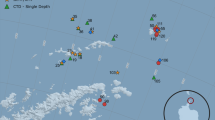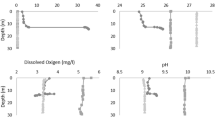The riddle is solved of how vast crab populations can thrive in an extreme, toxic habitat.
Abstract
The crab Xenograpsus testudinatus lives at enormously high densities around the sulphur-rich hydrothermal vents found in shallow waters off Taiwan, even though this acidic environment is low in nutrients. Here we show that these crabs swarm out of their crevices at slack water and feed on the vast numbers of zooplankton that are killed by the vents' sulphurous plumes, and that rain down like marine ‘snow’. This opportunistic feeding behaviour explains how the crabs are able to survive in the adverse toxic environment of these shallow hydrothermal vents.
Similar content being viewed by others
Main
Investigation into the ecology of animals living in deep-water hydrothermal vents has been extensive1,2, but much less is known about those living in shallow-water systems (at depths of less than 200 m)2,3,4,5. Compared with the species-rich communities associated with deep-water vents1,2, shallow-water vents are low in animal diversity and their ecosystems are simple — only two species of brachyuran crab, X. novaeinsularis and X. testudinatus, have been identified so far5,6,7,8.
The shallow-water vents off Kueishan Island (121° 57' E, 24° 50' N; Fig. 1, and see supplementary information) in northeastern Taiwan are part of the Okinawa Arc9. In this unusual system, the vent discharges are highly acidic (pH 1.75–4.60) and sulphur-rich10 — with up to nine large smokers (2–6 m in height) at any one time spewing sulphurous plumes and bubbles of gas (mainly carbon dioxide, nitrogen, oxygen, sulphur dioxide and hydrogen sulphide), which emerge at temperatures of 65–116 °C.
High sulphide concentrations are normally important for the establishment of a chemolithotrophic food-web1,2 and the growth of sulphur-dependent bacterial mats11. However, these food sources are not present in Kueishan, where the shallow-water vent discharges contain high concentrations of elemental sulphur (99.5% purity)10 and toxic volcanic gases (see supplementary information), so it is not surprising that the habitat is species-poor.
Almost nothing is known about the ecology of Xenograpsus crabs. The species X. novaeinsularis has been observed feeding on the ocean floor using its setae-tipped pincers7 but its diet is not known. At Kueishan, X. testudinatus congregates in large numbers in vent crevices6,8 (at an average density of 364 crabs per square metre; Fig. 2a, and see supplementary information), and the question arises as to how this ecosystem can support such a substantial crab population. What are the crabs feeding on?
Our observations of the crabs at Kueishan show that X. testudinatus is feeding on zooplankton. During slack water, thousands of Xenograpsus crabs swarm out of the sulphur-rich crevices (Fig. 2b, and see movie in supplementary information) and begin to feed frantically on the sea floor over an area of a few square metres. This previously undescribed swarming behaviour is seen only during such slack-water periods. Dissection of Xenograpsus specimens revealed that their guts were full of zooplankton (mainly pelagic copepods). Studies of the mouthparts and gastric mill of Xenograpsus confirm that it is a scavenger12.
During optimal conditions, we witnessed a gradual precipitation of fine particulate matter and dead fish during slack water around the vents. Analysis of water samples collected at this time revealed a high concentration of inorganic particles and dead or narcotized zooplankton. During slack water, when currents are weak or absent, the vent plumes are directed vertically, instantly killing any organism in their path13 and causing it to drop straight down the water column. The mass of descending zooplankton has the appearance of falling snow.
As soon as the currents increase again and the deadly plume veers away, the bombardment by dead zooplankton ceases and the crabs return to their crevices. As tides in Taiwan are semidiurnal, crab feeding runs probably take place twice daily (although we have not confirmed this because diving at night is too dangerous).
The crabs time their foraging to coincide with these marine snowfalls in order to maximize their efficiency in harvesting the plankton kill. This opportunistic feeding behaviour by Xenograpsus crabs, which to our knowledge has not been seen in any other hydrothermal organism, represents a remarkable adaptation to their nutrient-poor environment.
References
Tunnicliffe, V. Annu. Rev. Oceanogr. Mar. Biol. 29, 319–407 (1991).
Van Dover, C. L. The Ecology of Deep-sea Hydrothermal Vents (Princeton Univ. Press, New Jersey, 2000).
Dando, P. R., Hughes, J. A. & Thiermann, F. Geol. Soc. Spec. Pub. 87, 303–317 (1995).
Southward, A. J. et al. J. Mar. Biol. Assn UK 77, 753–771 (1977).
Türkay, M. & Sakai, K. Senckenberg. Mar. 26, 25–35 (1995).
Ng, N. K., Huang, J. F. & Ho, P. H. Natl Taiwan Mus. Spec. Pub. Ser. 10, 191–199 (2000).
Takeda, M., Takeuchi, H. & Suganuma, H. Nat. Environ. Sci. Res. 6, 59–64 (1993).
Jeng, M. S., Clark, P. F. & Ng, P. K. L. J. Crust. Biol. 24, 188–212 (2004).
Liu, C. C. Proc. Geol. Soc. China 38, 229–242 (1995).
Kuo, F. W. Thesis, Inst. Mar. Geol. Chem., Natl Sun Yat Sen Univ. (2001).
Childress, J. J. & Fisher, C. R. Ocean. Mar. Biol. Annu. Rev. 30, 337–441 (1992).
Ng, N. K., Yang, S. & Ng, P. K. L. Crustaceana (submitted).
Kido, T. J. Tokyo Univ. Fish. 61, 59–63 (1975).
Author information
Authors and Affiliations
Corresponding author
Ethics declarations
Competing interests
The authors declare no competing financial interests.
Supplementary information
Supplementary Figure
Map of Kueshan island, showing the hydrothermal vents on eastern side of the island. Scale bar, 0.5 km. (JPG 155 kb)
Rights and permissions
About this article
Cite this article
Jeng, MS., Ng, N. & Ng, P. Hydrothermal vent crabs feast on sea ‘snow’. Nature 432, 969 (2004). https://doi.org/10.1038/432969a
Published:
Issue Date:
DOI: https://doi.org/10.1038/432969a
This article is cited by
-
Autochthony and isotopic niches of benthic fauna at shallow-water hydrothermal vents
Scientific Reports (2022)
-
Novel recombinant keratin degrading subtilisin like serine alkaline protease from Bacillus cereus isolated from marine hydrothermal vent crabs
Scientific Reports (2021)
-
Specialized adaptations allow vent-endemic crabs (Xenograpsus testudinatus) to thrive under extreme environmental hypercapnia
Scientific Reports (2020)
-
Ecology and trophic role of Oncholaimus dyvae sp. nov. (Nematoda: Oncholaimidae) from the lucky strike hydrothermal vent field (Mid-Atlantic Ridge)
BMC Zoology (2019)
-
Molluscan diversity in shallow water hydrothermal vents off Kueishan Island, Taiwan
Marine Biodiversity (2018)
Comments
By submitting a comment you agree to abide by our Terms and Community Guidelines. If you find something abusive or that does not comply with our terms or guidelines please flag it as inappropriate.





